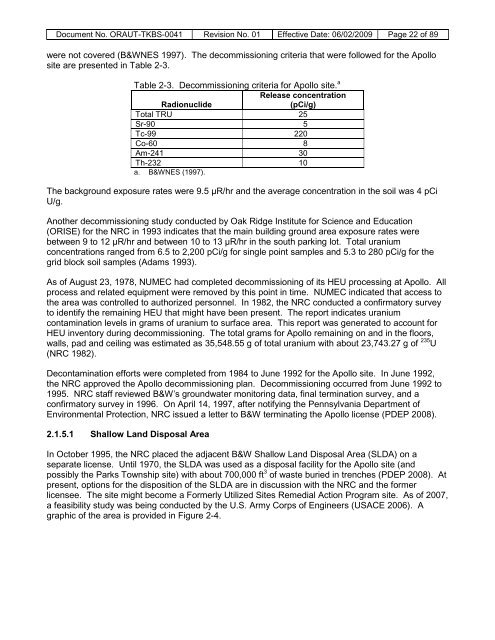ORAU TEAM Dose Reconstruction Project for NIOSH
ORAU TEAM Dose Reconstruction Project for NIOSH
ORAU TEAM Dose Reconstruction Project for NIOSH
You also want an ePaper? Increase the reach of your titles
YUMPU automatically turns print PDFs into web optimized ePapers that Google loves.
Document No. <strong>ORAU</strong>T-TKBS-0041 Revision No. 01 Effective Date: 06/02/2009 Page 22 of 89<br />
were not covered (B&WNES 1997). The decommissioning criteria that were followed <strong>for</strong> the Apollo<br />
site are presented in Table 2-3.<br />
Table 2-3. Decommissioning criteria <strong>for</strong> Apollo site. a<br />
Release concentration<br />
Radionuclide<br />
(pCi/g)<br />
Total TRU 25<br />
Sr-90 5<br />
Tc-99 220<br />
Co-60 8<br />
Am-241 30<br />
Th-232 10<br />
a. B&WNES (1997).<br />
The background exposure rates were 9.5 μR/hr and the average concentration in the soil was 4 pCi<br />
U/g.<br />
Another decommissioning study conducted by Oak Ridge Institute <strong>for</strong> Science and Education<br />
(ORISE) <strong>for</strong> the NRC in 1993 indicates that the main building ground area exposure rates were<br />
between 9 to 12 μR/hr and between 10 to 13 μR/hr in the south parking lot. Total uranium<br />
concentrations ranged from 6.5 to 2,200 pCi/g <strong>for</strong> single point samples and 5.3 to 280 pCi/g <strong>for</strong> the<br />
grid block soil samples (Adams 1993).<br />
As of August 23, 1978, NUMEC had completed decommissioning of its HEU processing at Apollo. All<br />
process and related equipment were removed by this point in time. NUMEC indicated that access to<br />
the area was controlled to authorized personnel. In 1982, the NRC conducted a confirmatory survey<br />
to identify the remaining HEU that might have been present. The report indicates uranium<br />
contamination levels in grams of uranium to surface area. This report was generated to account <strong>for</strong><br />
HEU inventory during decommissioning. The total grams <strong>for</strong> Apollo remaining on and in the floors,<br />
walls, pad and ceiling was estimated as 35,548.55 g of total uranium with about 23,743.27 g of 235 U<br />
(NRC 1982).<br />
Decontamination ef<strong>for</strong>ts were completed from 1984 to June 1992 <strong>for</strong> the Apollo site. In June 1992,<br />
the NRC approved the Apollo decommissioning plan. Decommissioning occurred from June 1992 to<br />
1995. NRC staff reviewed B&W’s groundwater monitoring data, final termination survey, and a<br />
confirmatory survey in 1996. On April 14, 1997, after notifying the Pennsylvania Department of<br />
Environmental Protection, NRC issued a letter to B&W terminating the Apollo license (PDEP 2008).<br />
2.1.5.1 Shallow Land Disposal Area<br />
In October 1995, the NRC placed the adjacent B&W Shallow Land Disposal Area (SLDA) on a<br />
separate license. Until 1970, the SLDA was used as a disposal facility <strong>for</strong> the Apollo site (and<br />
possibly the Parks Township site) with about 700,000 ft 3 of waste buried in trenches (PDEP 2008). At<br />
present, options <strong>for</strong> the disposition of the SLDA are in discussion with the NRC and the <strong>for</strong>mer<br />
licensee. The site might become a Formerly Utilized Sites Remedial Action Program site. As of 2007,<br />
a feasibility study was being conducted by the U.S. Army Corps of Engineers (USACE 2006). A<br />
graphic of the area is provided in Figure 2-4.

















